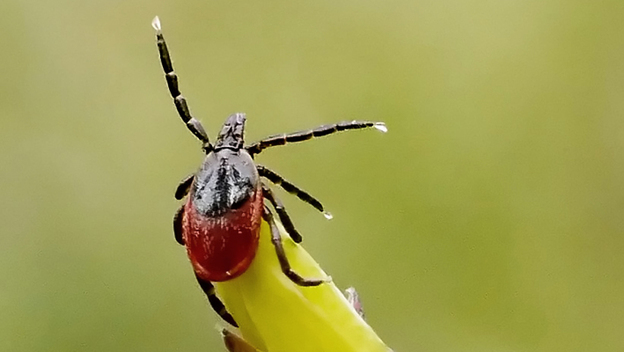 Enlarge Graham J. Hickling/University of Tennessee
Enlarge Graham J. Hickling/University of Tennessee This blacklegged tick, found in a Michigan forest, probably wouldn't mind you having her over for dinner.
Graham J. Hickling/University of TennesseeThis blacklegged tick, found in a Michigan forest, probably wouldn't mind you having her over for dinner.
Roll call for bloodsuckers. Vampires, step back.
For four years, researchers combed through hundreds of state parks and bushy areas looking for the culprit responsible for Lyme disease. The blacklegged tick, also known as a deer tick, transmits the disease through a bite.
About 20 percent of the 5,332 ticks collected in the Eastern half of the country were infected with the bacterium that causes Lyme disease.
Lead author Maria Diuk-Wasser says her suspicion about where her team would find infected ticks ? and the subsequent risk for the disease ? was confirmed when she mapped the data.
"We suspected strongly that we wouldn't find [infected ticks] in the South," the Yale epidemiologist tells Shots. "The tick is found in the South, but it's not infected and it doesn't feed on humans, but on lizards." Researchers found the highest risk of infection for humans in the Northeast, Mid-Atlantic and Upper Midwest.
 Enlarge Maria Diuk-Wasser/Yale School of Public Health
Enlarge Maria Diuk-Wasser/Yale School of Public Health The highest human risk for Lyme disease lies in the Northeast, Mid-Atlantic and Upper Midwest.
Maria Diuk-Wasser/Yale School of Public HealthThe highest human risk for Lyme disease lies in the Northeast, Mid-Atlantic and Upper Midwest.
?Previous maps have shown where people reported cases of the disease, but not where they contracted it. The new study includes a map of infected tick infestations. The findings appear in the American Journal of Tropical Medicine and Hygiene.
An estimated 30,000 cases of Lyme disease in the U.S. were reported in 2010, according to the Centers for Disease Control and Prevention. To get sick with the disease, a person has to be bitten by a tick that's carrying the bacterium Borrelia burgdorferi.
The ticks, usually in their immature, or nymphal, stage live in overgrown brush and leaf litter. The infection usually passes on to a human after a tick has been latched on for 36 to 48 hours. So, keep the ticks off you and make sure to check yourself after wading through shrubbery and other places the ticks hang out.
The western blacklegged tick (Ixodes pacificus) can also carry the bacterium that corresponds to Lyme disease. It lives along the Pacific Coast and feeds on birds, rodents, deer and other mammals.
The lone star tick (Amblyomma americanum) is a species prevalent in the South. It carries bacteria that can cause ehrlichiosis, tularemia and STARI, but not Lyme disease.
? Centers for Disease Control and Prevention
Early in the disease, people tend to suffer a bull's-eye-shaped rash, chills, a fever and aches. If treated early with antibiotics, patients usually recover in a few weeks. But if the condition goes untreated, later symptoms can include severe headaches, Bell's palsy and heart palpitations.
Lyme disease can be a tricky condition to diagnose, Diuk-Wasser says. Some activists believe the number of cases is actually higher than the is reported by CDC. (The center calculates the number of cases based on reports from county medical professionals.)
"It's more of a reporting problem," Phillip Baker, executive director of the American Lyme Disease Foundation, tells Shots. Diuk-Wasser agrees and says many cases are missed, misdiagnosed or aren't reported at all.
On the other hand, some tests can give false positives. There are a lot of people who think they have the disease but don't, Baker says.
Diuk-Wasser says she hopes the new map can act as a tool for doctors to understand how likely the disease is to show up in their neck of the woods.
"When a doctor sees a rash in the South, he shouldn't immediately be thinking it's Lyme disease," she says. "And in areas where the ticks are expanding to, doctors should start thinking that Lyme disease is a possibility."
She cautions that it's possible to get the disease in the South ? just highly unlikely.
Next up for Diuk-Wasser is a closer examination of areas where the species may be moving in. She's already heard from some collaborators that the population is growing in Virginia.
"Ticks have expanded following reforestation and deer expansion," she says.
2012 holidays prosperity yellow cab japan earthquake bosom buddies anderson cooper andrew bynum
No comments:
Post a Comment
Note: Only a member of this blog may post a comment.